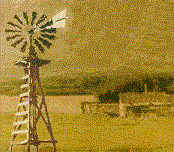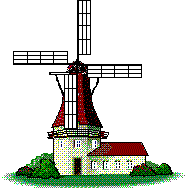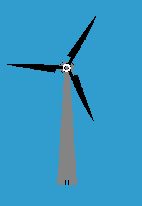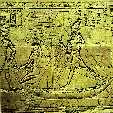History 1



Before You cleave Yourself to this windpage
some further very interesting internet-addresses to the subject windenergy.
History 1



2000 years B.C.

Even the ancient Egyptian used the wind energy to propell their
sailboats. Frieze of the temple of Edfu, river nile, Egypt.
14. Century
The following pictures were drawn and send by: Dr. Ulrich Alertz RWTH
Aachen, Germany
Historisches Institut, Lehrstuhl für Mittlere Geschichte.
The so called "Windwagen" by Guido von Vigevano.
That people can drive directly into the wind, this was prooved already
in the middleage, some hundred years ago. There exists a copy from an
old manuscrict of Guido von Vigevano of the year 1335, the
"Texaurus (treasure) regis francie" which shows the
construction of a windcart used for military purposes probably.
Guido was italian and technically well versed. He was court-physician
of the french king Philipp VI. The dimensionen of the carriage-wheels:
roughly 2,4 m diameter. Diameter of the 4 bladed windmillrotor roughly
6-8 Meter. Output of the system some kilowatts. With this energy
experts mean that the cart could reach nearly 30 mph, directly into the
wind.
16. Century
The Dutch are besides the Danish and the German the "Wind
Nation Number One" in Europe in the Middle Ages.
Around 1900
Around the turn of the century, it was the time of the so called
"western mills", the multibladed metal sheet rotors, the slow
running windturbines, especially for the purposes of water pumping. The
starting torque of these machines is pretty good high.
1932
Hermann Honnef proposed in den thirties the idea of huge contrarotating
rotors with ringgenerators built-in. Rotor and "stator" of
the elektric machine belong equally corresponding to one of the
contrarotating multibladed rotors. The diameter of the ringgenerator
reached 120 meter, the diameter totally was 160 meter. The output of
this giant should be 20 MW at a windspeed of 15 m/s. The projekt
remained only a paper study.
Nevertheless, Honnef is an important pioneer of windenergy utilization.
He proposed early, as first, the"offshore"-technic for
windenergy converters.
His plant was installed offshore, floating on a anchored pontoon,
harvesting the wind circular, like a grasseating sheep pinned by a rope
to a peg. The pontoon takes always the right position, floating
downstream away.
1942
The wind test field of the company Ventimotor at the airport of Weimar
This year pass for the starting point of modern wind energy
utilization. Ulrich Hütter finished as assistent professor at the
"Ingenieurschule Weimar" his masters thesis: "Beitrag
zur Schaffung von Gestaltungsgrundlagen für die
Windkraftwerke", which means: Creation of rules for the layout
of wind energy converters. In this thesis he wrote down the theoretic
basics for all modern free- and highspeedrunning turbines (in german:
"Freifahrende schnellaufende Turbinen"), with 2 or 3
rotorblades.
His blade-element-momentum-theory, developed with excellent
aeronautical knowledge, is even today current. His theory can be
learned by the students in lectures at the University of Stuttgart as
optional lecture.
1942
In world war II, in the years 1941 to 1945, on the hill called
Grandpa's Knob, nearby Rutland,
state Vermont, USA, 330 km northward of New York, there was erected a
1250 kW wind energy converter, build by Smith/Putnam, two famous
designing engineers.
Diameter of the plant 53,23 meter, height of tower 32,6 meter,
rotorshaft diameter 610 mm. Each of the two rotorblades, material
steel, has had a mass of 8 tons. 1942 accured an accident. In a heavy
storm the plant loosed one blade. It flew away and was found more than
230 Meter aside the tower. In the year 1945 this pilot plant was shut
down.
 doerner@ifb.uni-stuttgart.de
doerner@ifb.uni-stuttgart.de
![]() Since
24th mars 1997, updated continuously
Since
24th mars 1997, updated continuously